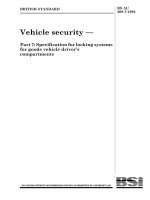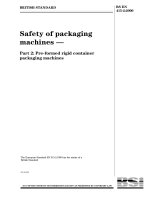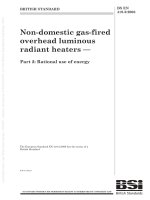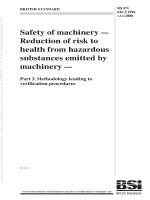Bsi bs en 60801 2 1993 (1999) iec 801 2 1991
Bạn đang xem bản rút gọn của tài liệu. Xem và tải ngay bản đầy đủ của tài liệu tại đây (1.05 MB, 32 trang )
BRITISH STANDARD
Electromagnetic
compatibility for
industrial-process
measurement and
control equipment —
Part 2: Electrostatic discharge
requirements
The European Standard EN 60801-2:1993 has the status of a
British Standard
UDC 621.3.011-5
BS EN
60801-2:1993
IEC 801-2:
1991
BS EN 60801-2:1993
Cooperating organizations
The European Committee for Electrotechnical Standardization (CENELEC),
under whose supervision this European Standard was prepared, comprises the
national committees of the following countries:
Austria
Belgium
Denmark
Finland
France
Germany
Greece
Iceland
Ireland
Italy
Luxembourg
Netherlands
Norway
Portugal
Spain
Sweden
Switzerland
United Kingdom
This British Standard, having
been prepared under the
direction of the
Industrial-process
Measurement and Control
Standards Policy Committee,
was published under the
authority of the Standards
Board and comes
into effect on
15 June 1993
Amendments issued since publication
© BSI 02-1999
Amd. No.
The following BSI references
relate to the work on this
standard:
Committee reference PCL/1
Special announcement BSI News
May 1993
ISBN 0 580 21840 6
Date
Comments
BS EN 60801-2:1993
Contents
© BSI 02-1999
Cooperating organizations
National foreword
Page
Inside front cover
ii
Foreword
Text of EN 60801-2
National annex NA (informative) Committees responsible
National annex NB (informative) Cross-references
2
3
Inside back cover
Inside back cover
i
BS EN 60801-2:1993
National foreword
This British Standard has been prepared under the direction of the
Industrial-process Measurement and Control Standards Policy Committee and is
the English language version of EN 60801-2:1993 Electromagnetic compatibility
for industrial-process measurement and control equipment — Part 2: Electrostatic
discharge requirements, published by the European Committee for
Electrotechnical Standardization (CENELEC). It is identical with
IEC 801-2:1991 published by the
International Electrotechnical Commission (IEC).
This Standard supersedes BS 6667-2:1985, which is withdrawn.
A British Standard does not purport to include all the necessary provisions of a
contract. Users of British Standards are responsible for their correct application.
Compliance with a British Standard does not of itself confer immunity
from legal obligations.
Summary of pages
This document comprises a front cover, an inside front cover, pages i and ii,
the EN title page, pages 2 to 26, an inside back cover and a back cover.
This standard has been updated (see copyright date) and may have had
amendments incorporated. This will be indicated in the amendment table on
the inside front cover.
ii
© BSI 02-1999
EUROPEAN STANDARD
EN 60801-2
NORME EUROPÉENNE
March 1993
EUROPÄISCHE NORM
UDC 621.3.011-5
Supersedes HD 481.2 S1:1987
Descriptors: Industrial-process measurement and control, electromagnetic compatibility, electrostatic interference, test protocol
with respect to electrostatic interference, severity levels with respect to electrostatic interference
English version
Electromagnetic compatibility for industrial-process
measurement and control equipment
Part 2: Electrostatic discharge requirements
(IEC 801-2:1991)
Compatibilité électromagnétique pour les
matériels de mesure et de commande dans les
processus industriels
Partie 2: Prescriptions relatives aux décharges
électrostatiques
(IEC 801-2:1991)
Elektromagnetische Verträglichkeit von M-,
Steuer- und Regeleinrichtungen in der
industriellen Proztechnik
Teil 2: Stưrfestigkeit gegen die Entladung
statischer Elektrizität
(IEC 801-2:1991)
This European Standard was approved by CENELEC on 1992-2-09.
CENELEC members are bound to comply with the CEN/CENELEC Internal
Regulations which stipulate the conditions for giving this European Standard
the status of a national standard without any alteration.
Up-to-date lists and bibliographical references concerning such national
standards may be obtained on application to the Central Secretariat or to any
CENELEC member.
This European Standard exists in three official versions (English, French,
German). A version in any other language made by translation under the
responsibility of a CENELEC member into its own language and notified to the
Central Secretariat has the same status as the official versions.
CENELEC members are the national electrotechnical committees of Austria,
Belgium, Denmark, Finland, France, Germany, Greece, Iceland, Ireland, Italy,
Luxembourg, Netherlands, Norway, Portugal, Spain, Sweden, Switzerland and
United Kingdom.
CENELEC
European Committee for Electrotechnical Standardization
Comité Européen de Normalisation Electrotechnique
Europäisches Komitee für Elektrotechnische Normung
Central Secretariat: rue de Stassart 35, B-1050 Brussels
© 1993 Copyright reserved to CENELEC members
Ref. No. EN 60801-2:1993 E
EN 60801-2:1993
Foreword
Page
The CENELEC questionnaire procedure, performed
for finding out whether or not the International
Standard IEC 801-2:1991 could be accepted without
textual changes, has shown that no common
modifications were necessary for the acceptance as
European Standard.
The reference document was submitted to the
CENELEC members for formal vote and was
approved by CENELEC as EN 60801-2
on 9 December 1992.
The following dates were fixed:
— latest date of publication of
an identical national
standard
(dop)1993-12-01
— latest date of withdrawal of
conflicting national
standards
(dow)1993-12-01
For products which have complied with
HD 481.2 S1:1987 before 1993-12-01, as shown by
the manufacturer or by a certification body, this
previous standard may continue to apply for
production until 1998-12-01.
Annexes designated “normative” are part of the
body of the standard. Annexes designated
“informative” are given only for information. In this
standard, Annex A is informative and Annex B and
Annex ZA are normative.
Contents
Foreword
1
Scope and object
2
Normative reference
3
General
4
Definitions/Terminology
5
Severity levels
6
Test generator (ESD)
6.1 Characteristics and performance
of the ESD generator
6.2 Verification of the characteristics
of the ESD generator
7
Test set-up
7.1 Test set-up for tests performed in
laboratories
7.2 Test set-up for post-installation tests
8
Test procedure
8.1 Laboratory reference conditions
8.2 EUT exercising
2
Page
2
3
3
3
3
4
4
5
5
5
6
7
7
7
7
8.3
Application of the static electricity
discharges
9
Evaluation of the test results
Annex A (informative) — Explanatory notes
Annex B (normative) — Constructional details
Annex ZA (normative) Other international
publications quoted in this standard
with the references of the relevant European
publications
Figure 1 — Simplified diagram of the ESD
generator
Figure 2 — Typical arrangement for
verification of the ESD generator
performance
Figure 3 — Typical waveform of the
output current of the ESD generator
Figure 4 — Discharge electrodes of
the ESD generator
Figure 5 — Example of test set-up for
table-top equipment, laboratory tests
Figure 6 — Example of test set-up for
floor-standing equipment, laboratory tests
Figure 7 — Example of test set-up for
equipment, post-installation tests
Figure A.1 — Maximum values of
electrostatic voltages to which operators
may be charged while in contact with
the materials mentioned in
clause A.2
Figure B.1 — Construction details
of the resistive load
Figure B.2 — Material and finish: silver-plated
copper or silver-plated brass
Figure B.3 — Material and finish: silver-plated
copper or silver-plated brass
Figure B.4 — Material and finish: silver-plated
copper or silver-plated brass 1 mm thick
Figure B.5 — Material and finish: silver-plated
copper or silver-plated brass 1 m thick
Figure B.6 — Material and finish: silver-plated
copper or silver-plated brass
Figure B.7 — Material and finish: silver-plated
copper or silver-plated
Table 1.a — Severity levels
Table 1.b — Severity levels
Table 2 — Waveform parameters
7
8
16
19
25
9
10
11
12
13
14
15
18
20
21
22
23
23
24
24
4
4
6
© BSI 02-1999
EN 60801-2:1993
1 Scope and object
This part 2 of the International Standard defines
the immunity requirements and test methods for
equipment which must withstand electrostatic
discharges, from operators directly, and to adjacent
objects. Several severity levels are defined which
relate to different environmental and installation
conditions.
These requirements are primarily developed for,
and are applicable to, industrial-process
measurement and control instrumentation.
Most aspects of the standard, such as simulation
parameters and test set-ups, may apply to other
equipment, yet other aspects such as severity levels
and performance criteria may not apply to other
equipment.
This document is intended to be identified as a basic
EMC publication, in accordance with
IEC Guide 107.
The object of this Part 2 is to establish a common
reference for evaluating the performance of
industrial-process measurement and control
instrumentation when subjected to electrostatic
discharges. In addition, it includes electrostatic
discharges which may occur from personnel to
objects near vital instrumentation.
2 Normative reference
The following standard contains provisions which,
through reference in this text, constitute provisions
of this International Standard. At the time of
publication, the edition indicated was valid. All
standards are subject to revision, and parties to
agreements based on this International Standard
are encouraged to investigate the possibility of
applying the most recent edition of the standard
indicated below. Members of IEC and ISO maintain
registers of currently valid International Standards.
IEC 50(161):1990, International Electrotechnical
Vocabulary — Chapter 161: Electromagnetic
compatibility.
3 General
This part relates to equipment, systems,
sub-systems and peripherals which may be involved
in static electricity discharges owing to
environmental and installation conditions, such as
low relative humidity, use of low conductivity
(artificial fibre) carpets, vinyl garments, etc. which
may exist in all locations classified in standards
relevant to industrial process measuring and
control instrumentation (for more detailed
information, see clause A.1 of Annex A).
© BSI 02-1999
The tests described in this Part 2 are considered to
be a first step in the direction of commonly used
tests for the qualitative evaluation of the
performance of all electronic equipment as referred
to in clause 1.
NOTE From the technical point of view the precise term for this
phenomenon would be “static electricity discharge”. However, the
term “electrostatic discharge” (ESD) is widely used in the
technical world and in technical literature. Therefore, it has been
decided to retain the term ESD in the title of this Part 2.
4 Definitions/Terminology
For the purposes of this International Standard, the
following definitions apply.
4.1
degradation (of performance)
an undesired departure in the operational
performance of any device, equipment or system
from its intended performance [IEV 161-01-19]
NOTE The term “degradation” can apply to temporary or
permanent failure.
4.2
electromagnetic compatibility (EMC)
the ability of an equipment or system to function
satisfactorily in its electromagnetic environment
without introducing intolerable electromagnetic
disturbances to anything in that environment
[IEV 161-01-07]
4.3
antistatic material
ESD-protective material having a surface resistivity
greater than 105 but not greater than 1011 ohms per
square
4.4
energy storage capacitor
the capacitor of the ESD-generator representing the
capacity of a human body charged to the test voltage
value. This may be provided as a discrete
component, or a distributed capacitance
4.5
ESD
refers to static electricity discharge
4.6
EUT
equipment under test
4.7
ground reference plane (GRP)
a flat conductive surface whose potential is used as
a common reference [IEV 161-04-36]
3
EN 60801-2:1993
4.8
coupling plane
a metal sheet or plate, to which discharges are
applied to simulate electrostatic discharge to objects
adjacent to the EUT
HCP: Horizontal Coupling Plane; VCP: Vertical
Coupling Plane
4.9
holding time
interval of time within which the decrease of the test
voltage due to leakage, prior to the discharge, is not
greater than 10 %
4.10
static electricity discharge; ESD
a transfer of electrostatic charge between bodies of
different electrostatic potential, in proximity or
through direct contact [IEV 161-01-22]
4.11
immunity (to a disturbance)
the ability of a device, equipment or system to
perform without degradation in the presence of an
electromagnetic disturbance [IEV 161-01-20]
Contact discharge is the preferred test method. Air
discharges shall be used where contact discharge
cannot be applied. Voltages for each test method are
given in Table 1.a and Table 1.b. The voltages
shown are different for each method due to the
differing methods of test. It is not intended to imply
that the test severity is equivalent between test
methods. Further information is given in
clauses A.3, A.4 and A.5 of Annex A.
Table 1.a — Severity levels
Level
kV
4.13
air discharge method
a method of testing, in which the charged electrode
of the test generator is approached to the EUT, and
the discharge actuated by a spark to the EUT
4.14
direct application
application of the test directly to the EUT
4.15
indirect application
application of the test to a coupling plane in the
vicinity of the EUT, and simulation of personnel
discharge to objects which are adjacent to the EUT
5 Severity levels
The severity levels shown in Table 1 are
recommended for the ESD test. All lower levels
must be satisfied.
Details concerning the various parameters which
may influence the voltage level to which the human
body may be charged are given in clause A.2 of
Annex A. Annex A.4 also contains examples of the
application of the severity levels related to
environmental (installation) classes.
4
2
4
6
8
Special
1
2
3
4
xa
a
“x” is an open level. The level is subject to negotiations and
has to be specified in the dedicated equipment specification. If
higher voltages than those shown are specified, special test
equipment may be needed.
Table 1.b — Severity levels
4.12
contact discharge method
a method of testing, in which the electrode of the
test generator is held in contact with the EUT, and
the discharge actuated by the discharge switch
within the generator
Test voltage Contact discharge
Level
Test voltage Air discharge
kV
1
2
3
4
xa
2
4
8
15
Special
a “x”
is an open level. The level is subject to negotiations and
has to be specified in the dedicated equipment specification. If
higher voltages than those shown are specified, special test
equipment may be needed.
6 Test generator (ESD)
The test generator consists, in its main parts, of:
— charging resistor Rch;
— energy-storage capacitor Cs;
— distributed capacitance Cd;
— discharge resistor Rd;
— voltage indicator;
— discharge switch;
— interchangeable tips of the discharge electrode
(see Figure 4);
— discharge return cable;
— power supply unit.
© BSI 02-1999
EN 60801-2:1993
A simplified diagram of the ESD generator is given
in Figure 1. Constructional details are not given.
The generator shall meet the requirements of 6.1
and 6.2.
6.1 Characteristics and performance of the
ESD generator
— energy storage capacitance
(Cs + Cd): 150 pF ± 10 %;
— discharge resistance (Rd): 330 7 ± 10 %;
— charging resistance (Rch): between 50 M7
and 100 M7;
— output voltage (see note 1):
up to 8 kV (nominal) for contact discharge;
up to 15 kV (nominal) for air discharge;
— tolerance of the output voltage
indication: ± 5 %;
— polarity of the output voltage: positive and
negative;
— holding time: at least 5 s;
— discharge, mode of operation
(see note 2): single discharge (time between
successive discharges at least 1 s);
— waveshape of the discharge current: see 6.2.
NOTE 1 Open circuit voltage measured at the energy
storage capacitor.
NOTE 2 The generator should be able to generate at a
repetition rate of at least 20 discharges per second for
exploratory purposes only.
The generator shall be provided with means of
preventing unintended radiated or conducted
emissions, of either pulse or continuous type, so as
not to disturb the EUT or auxiliary test equipment
by parasitic effects.
The energy storage capacitor, the discharge resistor,
and the discharge switch shall be placed as close as
possible to the discharge electrode. The dimensions
of the discharge tips are given in Figure 4. For the
air discharge test method the same generator is
used and the discharge switch has to be closed. The
tip of the generator has to be the round IEC tip.
The discharge return cable of the test generator
shall be in general 2 m long, and constructed to
allow the generator to meet the waveform
specification. It shall be sufficiently insulated to
prevent the flow of the discharge current to
personnel or conducting surfaces other than via its
termination, during the ESD test.
In cases where a 2 m length of the discharge return
cable is insufficient (e.g. for tall EUTs), a length not
exceeding 3 m may be used, but compliance with the
waveform specification shall be verified.
© BSI 02-1999
6.2 Verification of the characteristics of the
ESD generator
In order to compare the test results obtained from
different test generators, the characteristics shown
in Table 2 shall be verified using the discharge
return cable to be used in the testing.
The waveform of the output current of the ESD
generator for the verification procedure shall
conform to Figure 3.
The values of the parameters of the discharge
current shall be verified with 1 000 MHz bandwidth
measuring instrumentation. A lower bandwidth
implies limitations in the measurement of rise time
and amplitude of the first current peak.
For verification, the tip of the discharge electrode
shall be contacted directly to the current-sensing
transducer, and the generator operated in the
contact discharge mode.
The constructional arrangement of the
current-sensing transducer for verifying the ESD
generator characteristics is given in Figure 2.
Further details of a possible form of the
current-sensing transducer are given in Annex B.
Other arrangements that imply the use of a
laboratory Faraday cage having dimensions
different from those in Figure 2 are allowed;
separation of the Faraday cage from the target
plane is also allowed, but in both cases the distance
between the sensor and the grounding terminal
point of the ESD generator shall be respected (1 m),
as well as the layout of the discharge return cable.
The ESD generator shall be recalibrated at defined
time periods in accordance with a recognized quality
assurance system.
7 Test set-up
The test set-up consists of the test generator, EUT
and auxiliary instrumentation necessary to perform
direct and indirect application of discharges to the
EUT as applicable, in the following manner:
a) contact discharge to the conductive surfaces
and to coupling planes;
b) air discharge at insulating surfaces.
Two different types of tests can be distinguished:
— type (conformance) tests performed in
laboratories;
— post installation tests performed on equipment
in its final installed conditions.
5
EN 60801-2:1993
Table 2 — Waveform parameters
Indicated
voltage
Level
First peak
current of
discharge ± 10 %
kV
1
2
3
4
2
4
6
8
A
7,5
15
22,5
30
The preferred test method is that of type tests
performed in laboratories and the only accepted
method of demonstrating conformance with this
standard. The EUT shall be arranged as closely as
possible to arrangement in final installed
conditions.
7.1 Test set-up for tests performed in
laboratories
The following requirements apply to tests
performed in laboratories under environmental
reference conditions outlines in 8.1.
A ground reference plane shall be provided on the
floor of the laboratory. It shall be a metallic sheet
(copper or aluminium) of 0,25 mm minimum
thickness; other metallic materials may be used but
they shall have at least 0,65 mm thickness. The
minimum size of the reference plane is 1 m2) the
exact size depending on the dimensions of the EUT.
It shall project beyond the EUT or coupling plane by
at least 0,5 m on all sides, and shall be connected to
the protective grounding system. Local safety
regulations shall always be met.
The EUT shall be arranged and connected according
to its functional requirements. A distance of 1 m
minimum shall be provided between the equipment
under test and the walls of the laboratory and any
other metallic structure.
The EUT shall be connected to the grounding
system in accordance with its installation
specifications. No additional grounding connections
are allowed.
The positioning of the power and signal cables shall
be representative of installation practice.
The discharge return cable of the ESD generator
shall be connected to the ground reference plane.
The total length of this cable is in general 2 m.
In cases where this length exceeds the length
necessary to apply the discharges to the selected
points, the excess length shall, where possible, be
placed non-inductively off the ground reference
plane and shall not come closer than 0,2 m to other
conductive parts in the test set-up.
6
Rise time tr with
discharge switch
Current (± 30 %)
at 30 ns
ns
0,7 to 1
0,7 to 1
0,7 to 1
0,7 to 1
Current (± 30 %)
at 60 ns
A
4
8
12
16
A
2
4
6
8
The connection of the earth cables to the ground
reference plane and all bondings shall be of low
impedance, for example by using clamping devices
for high frequency applications.
Where coupling planes are specified, for example to
allow indirect application of the discharge, they
shall be constructed from the same material type
and thickness as that of the ground reference plane,
and shall be connected to the GRP via a cable with
a 470 k7 resistor located at each end. These
resistors shall be capable of withstanding the
discharge voltage and shall be insulated to avoid
short circuits to the GRP when the cable lies on the
GRP.
Additional specifications for the different types of
equipment are given below.
7.1.1 Table-top equipment
The test set-up shall consist of a wooden table, 0,8 m
high, standing on the ground reference plane. A
horizontal coupling plane (HCP), 1,6 m × 0,8 m,
shall be placed on the table. The EUT and cables
shall be isolated from the coupling plane by an
insulating support 0,5 mm thick.
If the EUT is too large to be located 0,1 m minimum
from all sides of the HCP, an additional, identical
HCP shall be used, placed 0,3 m from the first, with
the short sides adjacent. The table has to be
enlarged or two tables may be used. The HCPs shall
not be bonded together, other than via the resistive
cable to the GRP.
Any mounting feet associated with the EUT shall
remain in place.
An example of the test set-up for table-top
equipment is given in Figure 5.
7.1.2 Floor-standing equipment
The EUT and cables shall be isolated from the
ground reference plane by an insulating support
about 0,1 m thick.
An example of the test set-up for floor-standing
equipment is given in Figure 6.
Any mounting feet associated with the EUT shall
remain in place.
© BSI 02-1999
EN 60801-2:1993
7.2 Test set-up for post-installation tests
8.2 EUT exercising
These tests are optional and not mandatory for
certification tests; they shall be applied only when
agreed between manufacturer and customer. It has
to be considered that other co-located equipment
may be unacceptably affected.
The equipment or system shall be tested in its final
installed conditions. In order to facilitate a
connection for the discharge return cable, a ground
reference plane shall be placed on the floor of the
installation close to the EUT at about 0,1 m
distance. This plane should be of copper or
aluminium not less than 0,25 mm thick. Other
metallic materials may be used providing the
minimum thickness is 0,65 mm. The plane should
be approximately 0,3 m wide, and 2 m in length
where the installation allows.
This ground reference plane should be connected to
the protective earthing system. Where this is not
possible, it should be connected to the earthing
terminal of the EUT, if available.
The discharge return cable of the ESD generator
shall be connected to the reference plane at a point
close to the EUT. Where the EUT is installed on a
metal table, the table shall be connected to the
reference plane via a cable with a 470 k7 resistor
located at each end, to prevent a build-up of charge.
An example of the set-up for post-installation tests
is given in Figure 7.
Test programs and software shall be chosen so as to
exercise all normal modes of operation of the EUT.
The use of special exercising software is encouraged,
but permitted only where it can be shown that the
EUT is being comprehensively exercised.
For conformance testing, the EUT shall be
continually operated in its most sensitive mode
(program cycle) which shall be determined by
preliminary testing.
If monitoring equipment is required, it should be
decoupled in order to reduce the possibility of
erroneous failure indication.
8 Test procedure
8.1 Laboratory reference conditions
In order to minimize the impact of environmental
parameters on test results, the tests shall be carried
out in climatic and electromagnetic reference
conditions as specified in 8.1.1 and 8.1.2.
8.1.1 Climatic conditions
In the case of air discharge testing the climatic
conditions shall be within the following ranges:
— ambient temperature: 15 °C to 35 °C;
— relative humidity: 30 % to 60 %;
— atmospheric pressure: 68 kPa (680 mbar)
to 106 kPa (1 060 mbar).
NOTE Any other values are specified in the product
specification.
8.1.2 Electromagnetic conditions
The electromagnetic environment of the laboratory
shall not influence the test results.
© BSI 02-1999
8.3 Application of the static electricity
discharges
The testing shall be performed according to a test
plan. This should include:
— representative operating conditions of the
EUT;
— whether the EUT should be tested as table-top
or floor-standing;
— whether indirect application to the HCP or
VCP is required, and the positions of the VCP if
applicable;
— the points at which discharges are to be
applied;
— at each point, whether contact or air
discharges are to be applied;
— the severity level to be applied;
— the number of discharges to be applied at each
point for compliance testing;
— whether post-installation tests are also to be
applied.
It may be necessary to carry out some investigatory
testing to establish some aspects of the test plan.
8.3.1 Direct application of discharge to the
EUT
The static electricity discharges shall be applied
only to those points and surfaces of the EUT which
are accessible to personnel during normal usage
(which includes customer’s maintenance).
The application of discharges to any point of the
equipment which is accessible only for maintenance
purposes is not allowed unless agreed upon by
manufacturer and user.
The test voltage shall be increased from the
minimum to the selected test severity level, in order
to determine any threshold of failure (see clause 5).
The final severity level should not exceed the
product specification value in order to avoid damage
to the equipment.
7
EN 60801-2:1993
The test shall be performed with single discharges.
On preselected points at least ten single discharges
(in the most sensitive polarity) shall be applied.
For the time interval between successive single
discharges an initial value of 1 s is recommended.
Longer intervals may be necessary to determine
whether a system failure has occurred.
8.3.2.1 Horizontal coupling plane under the EUT
NOTE The points to which the discharges should be applied
may be selected by means of an exploration carried out at a
repetition rate of 20 discharges per second, or more.
8.3.2.2 Vertical coupling plane
The ESD generator shall be held perpendicular to
the surface to which the discharge is applied. This
improves repeatability of the test results.
The discharge return cable of the generator shall be
kept at a distance of at least 0,2 m from the EUT
whilst the discharge is being applied.
In the case of contact discharges, the tip of the
discharge electrode shall touch the EUT before the
discharge switch is operated.
In the case of painted surfaces covering a conducting
substrate, the following procedure shall be adopted:
If the coating is not declared to be an insulating
coating by the equipment manufacturer, then the
pointed tip of the generator shall penetrate the
coating so as to make contact with the conducting
substrate. Coating declared as insulating by the
manufacturer shall only be submitted to the air
discharge. The contact discharge test shall not be
applied to such surfaces.
In the case of air discharges, the round discharge tip
of the discharge electrode shall be approached as
fast as possible (without causing mechanical
damage) to touch the EUT. After each discharge, the
ESD generator (discharge electrode) shall be
removed from the EUT. The generator is then
retriggered for a new single discharge. This
procedure shall be repeated until the discharges are
completed. In the case of an air discharge test, the
discharge switch, which is used for contact
discharge, shall be closed.
8.3.2 Indirect application of the discharge
Discharges to objects placed or installed near the
EUT shall be simulated by applying the discharges
of the ESD generator to a coupling plane, in the
contact discharge mode.
In addition to the test procedure described in 8.3.1
the requirements of 8.3.2.1 and 8.3.2.2 shall be met.
8
At least 10 single discharges (in the most sensitive
polarity) shall be applied to the horizontal coupling
plane, at points on each side of the EUT (Figure 5).
The ESD generator shall be positioned vertically at
a distance of 0,1 m from the EUT, with the
discharge electrode touching the coupling plane.
At least 10 single discharges (in the most sensitive
polarity) shall be applied to the centre of one vertical
edge of the coupling plane (Figure 5 and Figure 6).
The coupling plane, of dimensions 0,5 m × 0,5 m, is
placed parallel to, and positioned at a distance
of 0,1 m from the EUT. Discharges shall be applied
to the coupling plane, with this plane in sufficient
different positions that the four faces of the EUT are
completely illuminated.
9 Evaluation of the test results
The variety and diversity of equipment and systems
to be tested make the task of establishing general
criteria for the evaluation of the effects of static
discharges on equipment and systems difficult.
The test results may be classified on the basis of the
operating conditions and the functional
specifications of the equipment under test,
according to the following performance criteria:
1) normal performance within the specification
limits;
2) temporary degradation or loss of function or
performance which is self-recoverable;
3) temporary degradation or loss of function or
performance which requires operator
intervention or system reset;
4) degradation or loss of function which is not
recoverable, due to damage of equipment
(components) or software, or loss of data.
In the case of acceptance tests, the test program and
the interpretation of the test results are subject to
agreement between manufacturer and user.
The test documentation shall include the test
conditions and the test results.
© BSI 02-1999
EN 60801-2:1993
NOTE Cd, qui ne figure pas sur le schéma, est une capacité répartie qui existe entre le générateur et l’EST, le plan de terre de
référence (GRP) et les plans de couplage. I1 n’est pas possible de représenter la capacité dans le circuit puisqu’elle est répartie sur
l’ensemble du générateur.
NOTE Cd, omitted in the figure, is a distributed capacitance which exists between the generator and the EUT, GRP, and coupling
planes. Because the capacitance is distributed over the whole of the generator, it is not possible to show this in the circuit.
Figure 1 — Simplified diagram of the ESD generator
© BSI 02-1999
9
EN 60801-2:1993
Figure 2 — Typical arrangement for verification of the ESD generator performance
10
© BSI 02-1999
EN 60801-2:1993
Les valeurs sont données dans le tableau 2
Values are given in Table 2
Figure 3 — Typical waveform of the output current of the ESD generator
© BSI 02-1999
11
EN 60801-2:1993
NOTE Le commutateur de décharge (par exemple relais à vide) doit être monté aussi près que possible de la tête de
l’électrode de décharge.
NOTE
The discharge switch (e.g. vacuum relay) shall be mounted as close as possible to the tip of the discharge electrode.
Figure 4 — Discharge electrodes of the ESD generator
12
© BSI 02-1999
EN 60801-2:1993
Figure 5 — Example of test set-up for table-top equipment, laboratory tests
© BSI 02-1999
13
EN 60801-2:1993
Figure 6 — Example of test set-up for floor-standing equipment, laboratory tests
14
© BSI 02-1999
EN 60801-2:1993
Figure 7 — Example of test set-up for equipment, post-installation tests
© BSI 02-1999
15
EN 60801-2:1993
Annex A (informative)
Explanatory notes
A.1 General considerations
The problem of protecting equipment against the
discharge of static electricity has gained
considerable importance for manufacturers and
users. The extensive use of microelectronic
components has emphasized the need to define the
aspects of the problem and to seek a solution in
order to enhance product/system reliability. The
problem of static electricity accumulation and
subsequent discharges becomes more relevant for
uncontrolled environments and the widespread
application of equipment and systems in a wide
range of industrial plants.
Equipment may also be subjected to
electromagnetic energies whenever discharges
occur from personnel to nearby objects.
Additionally, discharges can occur between metal
objects, such as chairs and tables, in the proximity
of equipment. However, based on limited experience
available to date, it is considered that the tests
described in this part 2 of the standard may
adequately simulate the effects of the latter
phenomenon. This aspect will be investigated and
may lead to an amendment of this standard.
The effect of operator discharge may be a simple
malfunction of the equipment or damage of
electronic components. The dominant effects can be
attributed to the parameters of the discharge
current (rise time, duration etc.).
The knowledge of the problem and the necessity to
have a tool to assist in the prevention of undesirable
effects due to the discharge of static electricity on
equipment, has initiated the development of the
standard testing procedure described in this
standard.
A.2 Influences of the environmental
conditions on the levels of charge
The generation of electrostatic charges is especially
favoured by the combination of synthetic fabrics and
dry atmosphere. There are many possible variations
in the charging process. A common situation is one
in which an operator walks over a carpet and at each
step loses or gains electrons from his body to the
fabric. Friction between the operator’s clothing and
his chair can also produce an exchange of charges.
The operator’s body may be charged either directly
or by electrostatic inductions; in the latter case a
conducting carpet will give no protection unless the
operator is adequately earthed to it.
The graphic representation of Figure A.1 shows the
voltage values to which different fabrics may be
charged depending on the relative humidity of the
atmosphere.
16
Equipment may be directly subjected to discharges
of voltage values up to several kilovolts, depending
on the type of synthetic fabric and the relative
humidity of the environment.
A.3 Relationship of environmental levels to air
and contact discharge
As a measurable quantity, static voltage levels
found in user environments have been applied to
define immunity requirements. However, it has
been shown that energy transfer is a function of the
discharge current rather than, as well as, of the
electrostatic voltage existing prior to the discharge.
Further, it has been found that the discharge
current typically is less than proportional to the
predischarge voltage in the higher level ranges.
Possible reasons for the non-proportional
relationship between predischarge voltage and
discharge current are:
— The discharge of high voltage charges typically
should occur through a long arcing path which
increases the rise time, hence keeping the higher
spectral components of the discharge current less
than proportional to the pre-discharge voltage.
— High charge voltage levels will more likely
develop across a small capacitance, assuming the
amount of charge should be constant for a typical
charge generation event. Conversely, high charge
voltages across a large capacitance would need a
number of successive generation events which is
less likely to occur. This means that the charge
energy tends to become constant between the
higher charge voltages found in the user
environment.
As a conclusion from the above, the immunity
requirements for a given user environment need to
be defined in terms of discharge current amplitudes.
Having recognized this concept, the design of the
tester is eased. Trade-off in the choice of tester
charge voltage and discharge impedance can be
applied to achieve desired discharge current
amplitudes.
A.4 Selection of severity levels
The test severity levels shall be selected in
accordance with the most realistic installation and
environmental conditions.
The installation and environmental classes
recommended are related to the severity levels
outlined in clause 5 of this standard.
© BSI 02-1999
EN 60801-2:1993
Class
Relative
humidity as
low as
Antistatic Synthetic
material
material
Maximum
voltage
%
1
2
3
4
35
10
50
10
kV
×
×
×
×
2
4
8
15
For some materials, for example, wood, concrete and
ceramic the probable level is not greater than
level 2.
NOTE It is important when considering the selection of an
appropriate test severity level for a particular environment to
understand the critical parameters of the ESD effect.
The most critical parameter is perhaps the rate of change of
discharge current which may be obtained through a variety of
combinations of charging voltage, peak discharge current and
rise time.
For example the required ESD stress for the 15 kV synthetic
material environment is more than adequately covered by
the 8 kV/30 A Class 4 test using the ESD generator contact
discharge defined in this standard.
However, in a very dry environment with synthetic materials,
higher voltages than 15 kV will occur.
In the case of testing equipment with insulating surfaces, the air
discharge method with voltages up to 15 kV may be used.
A.5 Selection of test points
The test points to be considered may, for example,
include the following locations as applicable:
— points on metallic sections of a cabinet which
are electrically isolated from ground;
— any point in the control or keyboard area and
any other point of man-machine communication,
such as switches, knobs, buttons, and other
operator-accessible areas;
— indicators, LEDs, slots, grilles, connector
hoods, etc.
A.6 Technical rationale for the use of the
contact discharge method
In general, the reproducibility of the previous test
method (air discharge) was influenced by, for
example, the speed of approach of the discharge tip,
humidity, and construction of the test equipment,
leading to variations in pulse rise time and
magnitude of the discharge current.
© BSI 02-1999
In previous designs of ESD testers, the ESD event
was simulated by discharging a charged capacitor
through a discharge tip onto the EUT, the discharge
tip forming a spark gap at the surface of the EUT.
The spark is a very complicated physical
phenomenon. It has been shown that with a moving
spark gap the resulting rise time (or rising slope) of
the discharge current can vary from less than 1 ns
to more than 20 ns as the approach speed is varied.
Keeping the approach speed constant does not
result in constant rise time. For some voltage/speed
combinations, the rise time still fluctuates by a
factor of up to 30.
One proposed way to stabilize the rise time is to use
a mechanically fixed spark gap. Although the rise
time is stabilized with this method, it cannot be
recommended because the resulting rise time is
much slower than the rise time of the natural event
to be simulated. The high-frequency content of the
real ESD event is not properly simulated with this
method. Using various types of triggering devices
(e.g. gas tubes or thyratrons) instead of the open
spark is another possibility, but such kinds of
triggering devices produce rise times which are still
too low compared to the rise times of the real ESD
event.
The only triggering device known today which is
able to produce repeatable and fast rising discharge
currents is the relay. The relay should have
sufficient voltage capability and a single contact (to
avoid double discharges in the rising part). For
higher voltages, vacuum relays prove to be useful.
Experience shows that by using a relay as the
triggering device, not only the measured discharge
pulse shape is much more repeatable in its rising
part, but also the test results with real EUTs are
more reproducible.
Consequently, the relay-driven impulse tester is a
device that produces a specified current pulse
(amplitude and rise time). This current is related to
the real ESD voltage, as described in clause A.3.
A.7 Selection of elements for the ESD
generator
A storage capacitance shall be used which is
representative of the capacitance of the human
body. A nominal value of 150 pF has been
determined suitable for this purpose.
A resistance of 330 7 has been chosen to represent
the source resistance of a human body holding a
metallic object such as a key or tool. It has been
shown that this metal discharge situation is
sufficiently severe to represent all human
discharges in the field.
17
EN 60801-2:1993
Figure A.1 — Maximum values of electrostatic voltages to which operators may be charged
while in contact with the materials mentioned in clause A.2
18
© BSI 02-1999
EN 60801-2:1993
Annex B (normative)
Constructional details
B.1 Current-sensing transducer
The constructional details for one form of
current-sensing transducer are shown in the
Figure B.1 to Figure B.7.
The following sequence of assembly should be
followed:
1) Solder the 25 load resistors “7”
(51 7, 5 %, 0,25 W) on to the output side disc “3”
and shave the soldered terminals.
2) Solder the 5 matching resistors “8”
(240 7, 5 %, 0,25 W) in a pentagonal disposition
on to the output connector, of Type N coaxial
construction.
3) Assemble the output side disc “3”, complete
with load resistors, on to the output connector
flange “1” using 4 screws M2,5 Pan Hd 6,5 mm
long.
© BSI 02-1999
4) Assemble the output connector complete with
matching resistors, “7” on to the output connector
flange “1” using 4 screws M3.
5) Solder the input disc “4”, with the screw
support for electrode “6” screwed and soldered, on
both the load and matching resistors group.
Shave the soldered terminals.
6) Screw the flat electrode disc “5” on the screw
support for electrode “6”, then assemble the
support for fixing “2” using 8 screws
M3 Pan Hd 6,5 mm long.
B.2 Inductive current probe
Description and constructional details are under
consideration.
19
EN 60801-2:1993
Pièce/Item
1
2
3
4
5
6
7
8
Nb/QTY
1
1
1
1
1
1
25
5
Boulons/Screws
M3 PAN HD SC × 6,5 mm LG
M2,5 PAN HD SC × 5,0 mm LG
Nb/QTY
12
3
Résistance/Resistor 51 7
Résistance/Resistor 240 7
Figure B.1 — Construction details of the resistive load
20
© BSI 02-1999
EN 60801-2:1993
Figure B.2 — Material and finish: silver-plated copper or silver-plated brass
© BSI 02-1999
21









